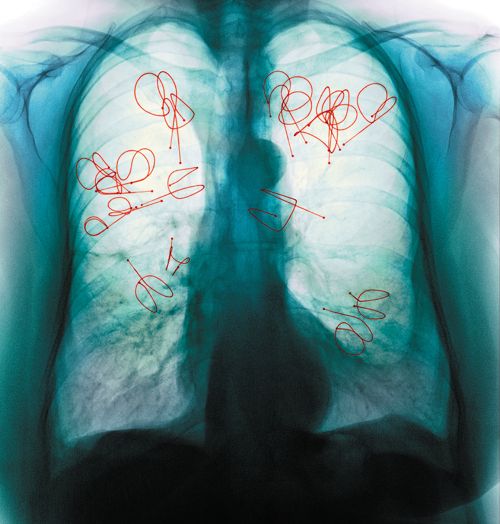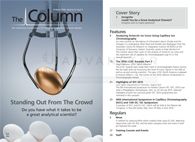Detecting Tuberculosis Using GC–MS
A new method for tuberculosis detection using gas chromatography–mass spectrometry has been developed.
Photo Credit: Science Photo Library/Getty Images

A new method for tuberculosis (TB) detection using gas chromatography–mass spectrometry (GC–MS) has been developed.1 Using an established biomarker known as Lipoarabinomannan (LAM), researchers have simplified a previously validated method measuring the closely linked D-arabinose.
According to the World Health Organization (WHO), in 2013, an estimated 9.0 million people developed TB with 1.5 million dying.2 A total of 360,000 of those were HIV positive, attesting to the close association of TB with HIV.2
Fortunately, TB is declining globally as a result of effective diagnosis and treatment. However, diagnosis relies on the demonstration of the bacteria responsible for TB, Mycobacterium tuberculosis (Mtb). This is accomplished using microscopy, cultures, and molecular testing, a time-consuming and expensive procedure.
TB remains unique among the major infectious diseases because it lacks an accurate and rapid point-of-care test. This is primarily the result of insufficient progress in biomarker discovery.2
In 2010 the WHO endorsed the Xpert MTB/RIF test for use in TB endemic countries.3 As a cartridge-based and automated diagnostic test, the Xpert MTB/RIF test represented a major milestone. The device identifies Mtb DNA and mutations associated with resistance to rifampicin (RIF) by nucleic acid amplification technique (NAAT).4,5,6
However, a reliable biomarker, if detectable on a simple, portable, and low cost platform, could greatly increase early detection, reducing not only disease morbidity but also transmission and support global TB control.
Current commercial detection assays measure LAM in urine as a marker for TB but these exhibit poor sensitivity, especially in individuals with a healthy immune system. This new method isolates LAM and converts it into its constituent monosaccharides (that is, D-arabinose, D-mannose) before quantifying D-arabinose as a proxy for LAM, using GC–MS.
Results indicated this method was effective and was successfully able to detect and measure urinary LAM in human clinical specimens by quantifying D-arabinose using chemical derivatization and GC–MS. Importantly this method was
non-discriminatory, with no dependence on country of origin, HIV coâinfection, or BCG vaccination. - L.B.
References
- D. Prithwiraj et al., PLoS ONE 10(12) (2015) doi:10.1371/journal.pone.0144088
- WHO. Global Tuberculosis Report 2014. http://www.who.int/tb/publications/global_report/en/WHO.2014
- WHO. WHO endorses new rapid tuberculosis test 2010. http://www.who.int/mediacentre/news/releases/2010/tb_test_20101208/en/
- P.M. Small and M. Pai., N. Engl. J. Med.363(11), 1070–1071 (2010).
- A. Van Rie et al., Expert Rev. Mol. Diagn.10(7), 937–946 (2010).
- C.C. Boehme et al., N. Engl. J. Med.363(11), 1005–1015 (2010).

Accelerating Monoclonal Antibody Quality Control: The Role of LC–MS in Upstream Bioprocessing
This study highlights the promising potential of LC–MS as a powerful tool for mAb quality control within the context of upstream processing.
Using GC-MS to Measure Improvement Efforts to TNT-Contaminated Soil
April 29th 2025Researchers developing a plant microbial consortium that can repair in-situ high concentration TNT (1434 mg/kg) contaminated soil, as well as overcome the limitations of previous studies that only focused on simulated pollution, used untargeted metabolone gas chromatography-mass spectrometry (GC-MS) to measure their success.
Prioritizing Non-Target Screening in LC–HRMS Environmental Sample Analysis
April 28th 2025When analyzing samples using liquid chromatography–high-resolution mass spectrometry, there are various ways the processes can be improved. Researchers created new methods for prioritizing these strategies.
Potential Obstacles in Chromatographic Analyses Distinguishing Marijuana from Hemp
April 28th 2025LCGC International's April series for National Cannabis Awareness Month concludes with a discussion with Walter B. Wilson from the National Institute of Standard and Technology’s (NIST’s) Chemical Sciences Division regarding recent research his team conducted investigating chromatographic interferences that can potentially inflate the levels of Δ9-THC in Cannabis sativa plant samples, and possible solutions to avoid this problem.

.png&w=3840&q=75)

.png&w=3840&q=75)



.png&w=3840&q=75)



.png&w=3840&q=75)












